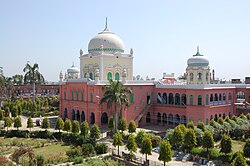Deoband
This article needs additional citations for verification. (February 2017) |
Deoband | |
|---|---|
Town | |
 | |
| Coordinates: 29°41′31″N 77°40′37″E / 29.692°N 77.677°E | |
| Country | |
| State | Uttar Pradesh |
| District | Saharanpur |
| Government | |
| • Body | Nagar Palika parishad Deoband |
| Elevation | 256 m (840 ft) |
| Population (2011)[1] | |
| • Total | 97,037 |
| Demonym | Deobandi |
| Language | |
| • Official | Hindi[2] |
| • Additional official | Urdu[2] |
| Time zone | UTC+5:30 (IST) |
| Area code | 01336 |
| Vehicle registration | UP-11 |
Deoband is a town and a municipality in Saharanpur district in the state of Uttar Pradesh, India, about 150 km (93 miles) from Delhi. Darul Uloom Deoband, an Islamic seminary and one of the largest Islamic Institutions of India is located there.[1]
Etymology[edit]
The native Hindi-Urdu name for the place is "Devband". According to one theory, it derives from "devi" (goddess) and "van" (forest), when this place was full of forests in the Mahabharata-era. A related argument is that it is derived from "devi" and "vandan" (praise), referring to the local Durga temples.[3][4]
An apocryphal legend states that it gets its name from daeva (demon) and band (imprison), the story being that prophet Suleiman had imprisoned wicked demons here.[4]
History[edit]
The 16th century Bhakti saint Shri Hith Harivansh Mahaprabhu and the founder of the Radhavallabh Sampradaya of Vaishnavism based in Vrindavan, lived in Deoband before his renunciation. He also established a temple here, dedicated to Radha-Krishna and named it "Radha-Navrangilal".[5]
Deoband is listed in the Ain-i-Akbari as a pargana under Saharanpur sarkar, producing a revenue of 6,477,977 dams for the imperial treasury and supplying a force of 300 infantry and 60 cavalry. It had a brick fort at the time.[6]
The Darul Uloom Deoband learning centre was established on 21 May 1866 by Fazlur Rahman Usmani, Sayyid Muhammad Abid, Muhammad Qasim Nanotawi, Mehtab Ali, Nehal Ahmad and Zulfiqar Ali Deobandi.[7][8][9] The Deobandi Islamic movement originated in the Darul Uloom.

Geography[edit]
Deoband is located at 29°42′N 77°41′E / 29.7°N 77.68°E.[10] It has an average elevation of 256 metres (840 ft).
Demographics[edit]
Deoband has a population of 97,037 of which 53,538 are males while 43,499 are females as per the report released by Census India 2011. The population of children aged 0–6 is 12,200 which is 12.57% of the total population. The sex ratio is 812 females per 1000 males against the state average of 912. The child sex ratio in Deoband is around 917 compared to the Uttar Pradesh state average of 902. The effective literacy rate (for population 7 years and above) is 75.23%, higher than the state average of 67.68% with male literacy of 79.59% and the female literacy rate is 69.77%. Out of the total population, 24,559 were engaged in work or business activity. Of this, 22,551 were males while 2,008 were females and 89.91% were engaged in main work. The Scheduled Caste population was 3,576. Deoband had a total of 16,530 households in 2011.[1]
Deoband Nagar Palika Parishad has a total administration over 15,630 houses to which it supplies basic amenities like water and sewage. It is also authorized to build roads within Nagar Palika Parishad limits and impose taxes on properties coming under its jurisdiction.[citation needed]
See also[edit]
References[edit]
- ^ a b c "Census 2011 - Deoband". censusindia.gov.in. Retrieved 26 March 2022.
- ^ a b "52nd Report of the Commissioner for Linguistic Minorities in India" (PDF). nclm.nic.in. Ministry of Minority Affairs. Archived from the original (PDF) on 25 May 2017. Retrieved 18 February 2019.
- ^ "देवबंद का नाम बदलना कितना आसान?". BBC Hindi (in Hindi). Retrieved 14 October 2022.
- ^ a b "Changing the Name of Deoband Will Not Have Any Impact on Darul-Uloom, Mr MLA". Urdu Media Monitor. 26 March 2017. Retrieved 14 October 2022.
- ^ "Deoband witness of childhood days of Sri Harivansh Mahaprabhu". www.radhavallabh.com. Retrieved 20 August 2020.
- ^ Abū al-Faz̤l ibn Mubārak; Blochmann, H. (Henry) (1873). The Ain I Akbari. Harvard University. Calcutta : Asiatic Society of Bengal. Retrieved 21 January 2021.
- ^ Muḥammad Miyan Deobandi. Ulama-e-Haq ke mujāhidāna kārnāme (in Urdu). New Delhi: Faisal Publications. pp. 44–47.
- ^ Roshen Dalal (2014). The Religions of India: A Concise Guide to Nine Major Faiths. Penguin UK. ISBN 9788184753967. Retrieved 30 May 2021.
- ^ "Introduction". www.darululoom-deoband.com.
- ^ "Deoband Shareef". Falling Rain Genomics, Inc.


